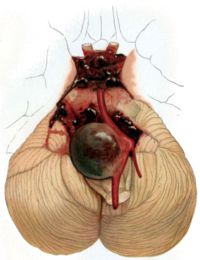
Photo from wikipedia
Introduction: Recent national utilization and in-hospital outcomes of stenting for intracranial atherosclerosis following emergent or elective hospitalizations are not well-established. Methods: Using validated codes, we identified all hospitalizations with stenting… Click to show full abstract
Introduction: Recent national utilization and in-hospital outcomes of stenting for intracranial atherosclerosis following emergent or elective hospitalizations are not well-established. Methods: Using validated codes, we identified all hospitalizations with stenting for intracranial atherosclerosis in the National Inpatient Sample (NIS) from 2010-2016. The primary outcome was in-hospital mortality. Poor outcome was defined as death or discharge to skilled nursing facility. We used multivariable models adjusting for relevant demographic, hospital and clinical variables to examine outcomes among hospitalizations with elective or non-elective procedures. We used NIS sampling weights to calculate utilization patterns and clinical outcomes across time. Results: A total of 4,733 eligible hospitalizations with intracranial stenting were identified during the study period (21% elective admissions). An abrupt decline in intracranial stenting was observed in the 3 rd quarter of 2011 after publication of the SAMMPRIS trial. After 2011, there were steadily increasing rates of hyperacute intracranial stenting combined with mechanical thrombectomy whereas elective intracranial stenting trended downward. In-hospital mortality for non-elective stenting was unchanged across the study period, whereas in-hospital mortality for elective intracranial stenting declined significantly. In multivariable models, age (OR, 1.1), female sex (OR, 1.64) and concomitant thrombectomy (OR, 1.95) were associated with poor outcome in the non-elective stenting cohort, whereas black race (OR, 2.1) and atrial fibrillation (OR, 3.61) were independent predictors for poor outcome in the elective stenting cohort (all p < 0.05). Conclusion: Elective hospitalizations for intracranial stenting accounted for approximately one-fifth of all procedures for intracranial atherosclerosis in the U.S. and were associated with improving outcomes from 2010 to 2016. Figure: Intracranial stenting utilization patterns for intracranial atherosclerosis in US (2010-2016).
Journal Title: Stroke
Year Published: 2020
Link to full text (if available)
Share on Social Media: Sign Up to like & get
recommendations!